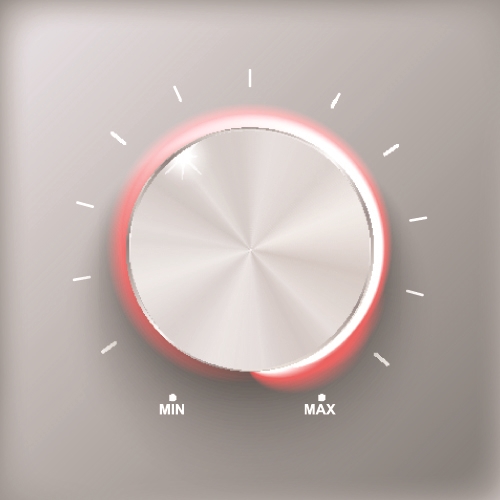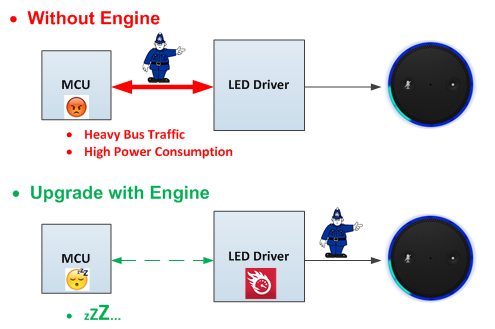-
Improve the User Experience with an LED Ring
Improve the User Experience with an LED Ring
David Xu
Products with good user experience can always receive positive feedback in the market. You can use audible, visual or tactile methods to improve the user experience for consumer electronics or smart home products like speakers, locks, smoke detectors and wearables. Visual is one of the most direct ways – and also one of the easiest – if you add a light-emitting diode (LED) ring. A good LED ring has various fancy effects, including smooth breathing, elegant chasing and rhythmic beating, Figure 1 illustrates an example of an LED Ring. It delivers a new soul to a product!
 Figure 1 LED Ring in Rotary Knob and Button
Figure 1 LED Ring in Rotary Knob and ButtonThe secret behind an LED ring is a very smart LED driver, which controls the current and pulse-width modulation (PWM) duty cycle of every red-green-blue (RGB) LED to achieve different colors and brightness levels. The PWM resolution of the LED driver is very important in order to achieve smooth color and brightness changes. Most LED drivers on the market offer 8-bit 256-step PWM control, which is not good enough to achieve an ultra-smooth effect, as the human eye can observe color and brightness jumps under low gray-scale conditions. TI’s TLC5955 48-channel LED driver resolves this problem; it has 16-bit 65,536-step resolution PWM control and 7-bit dot correction for every channel. An ultra-high 2% channel-to-channel current accuracy helps achieve perfect color and brightness consistency between different RGB LEDs.
To achieve sophisticated LED ring effects, the microcontroller (MCU) needs to refresh the LED driver’s internal registers continuously to control color and brightness. In some systems, the MCU is not strong enough to handle this. TI’s LP5569 is equipped with internal static random access memory (SRAM) for user-programmed sequences along with three programmable LED engines, which enables operation without processor control. Autonomous operation reduces system power consumption because you can put the processor into sleep mode, as shown in Figure 2.
 Figure 2 LED with Engine Control Help to Offload MCU
Figure 2 LED with Engine Control Help to Offload MCUWith more and more products integrating LED ring functionality, TI’s large RGB LED driver portfolio is expanding, adding new products to help you design systems more easily.
Additional Resources
- Check out the Status Indication reference design with LED and audio feedback.
- Learn about the Energy Harvesting and Fault indicator subsystem reference design.
IMPORTANT NOTICE AND DISCLAIMER
TI PROVIDES TECHNICAL AND RELIABILITY DATA (INCLUDING DATASHEETS), DESIGN RESOURCES (INCLUDING REFERENCE DESIGNS), APPLICATION OR OTHER DESIGN ADVICE, WEB TOOLS, SAFETY INFORMATION, AND OTHER RESOURCES “AS IS” AND WITH ALL FAULTS, AND DISCLAIMS ALL WARRANTIES, EXPRESS AND IMPLIED, INCLUDING WITHOUT LIMITATION ANY IMPLIED WARRANTIES OF MERCHANTABILITY, FITNESS FOR A PARTICULAR PURPOSE OR NON-INFRINGEMENT OF THIRD PARTY INTELLECTUAL PROPERTY RIGHTS.
These resources are intended for skilled developers designing with TI products. You are solely responsible for (1) selecting the appropriate TI products for your application, (2) designing, validating and testing your application, and (3) ensuring your application meets applicable standards, and any other safety, security, or other requirements. These resources are subject to change without notice. TI grants you permission to use these resources only for development of an application that uses the TI products described in the resource. Other reproduction and display of these resources is prohibited. No license is granted to any other TI intellectual property right or to any third party intellectual property right. TI disclaims responsibility for, and you will fully indemnify TI and its representatives against, any claims, damages, costs, losses, and liabilities arising out of your use of these resources.
TI’s products are provided subject to TI’s Terms of Sale (www.ti.com/legal/termsofsale.html) or other applicable terms available either on ti.com or provided in conjunction with such TI products. TI’s provision of these resources does not expand or otherwise alter TI’s applicable warranties or warranty disclaimers for TI products.
Mailing Address: Texas Instruments, Post Office Box 655303, Dallas, Texas 75265
Copyright © 2023, Texas Instruments Incorporated